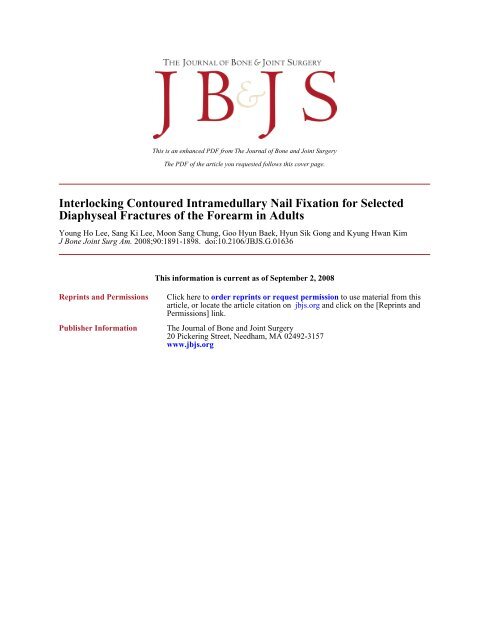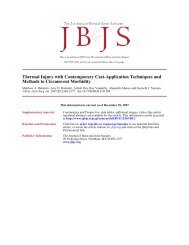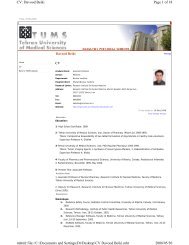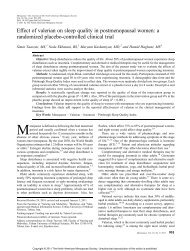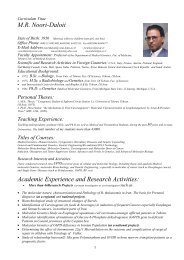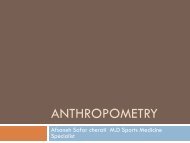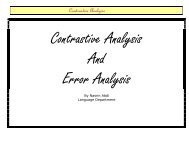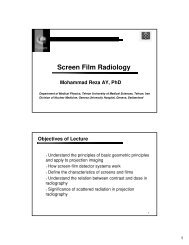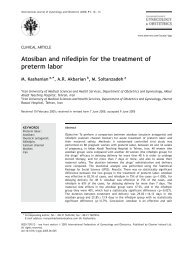Interlocking Contoured Intramedullary Nail Fixation for Selected ...
Interlocking Contoured Intramedullary Nail Fixation for Selected ...
Interlocking Contoured Intramedullary Nail Fixation for Selected ...
You also want an ePaper? Increase the reach of your titles
YUMPU automatically turns print PDFs into web optimized ePapers that Google loves.
This is an enhanced PDF from The Journal of Bone and Joint Surgery<br />
The PDF of the article you requested follows this cover page.<br />
<strong>Interlocking</strong> <strong>Contoured</strong> <strong>Intramedullary</strong> <strong>Nail</strong> <strong>Fixation</strong> <strong>for</strong> <strong>Selected</strong><br />
Diaphyseal Fractures of the Forearm in Adults<br />
Young Ho Lee, Sang Ki Lee, Moon Sang Chung, Goo Hyun Baek, Hyun Sik Gong and Kyung Hwan Kim<br />
J Bone Joint Surg Am. 2008;90:1891-1898. doi:10.2106/JBJS.G.01636<br />
Reprints and Permissions<br />
Publisher In<strong>for</strong>mation<br />
This in<strong>for</strong>mation is current as of September 2, 2008<br />
Click here to order reprints or request permission to use material from this<br />
article, or locate the article citation on jbjs.org and click on the [Reprints and<br />
Permissions] link.<br />
The Journal of Bone and Joint Surgery<br />
20 Pickering Street, Needham, MA 02492-3157<br />
www.jbjs.org
<strong>Interlocking</strong> <strong>Contoured</strong> <strong>Intramedullary</strong> <strong>Nail</strong><br />
<strong>Fixation</strong> <strong>for</strong> <strong>Selected</strong> Diaphyseal Fractures<br />
of the Forearm in Adults<br />
By Young Ho Lee, MD, Sang Ki Lee, MD, Moon Sang Chung, MD, Goo Hyun Baek, MD,<br />
Hyun Sik Gong, MD, and Kyung Hwan Kim, MD<br />
Investigation per<strong>for</strong>med at the Department of Orthopedic Surgery, Eulji University College of Medicine,<br />
Daejeon, and Seoul National University College of Medicine, Seoul, South Korea<br />
Background: Plate osteosynthesis is the most commonly used technique <strong>for</strong> the treatment of diaphyseal <strong>for</strong>earm<br />
fractures in adults. However, application of a plate can disrupt the periosteal blood supply and necessitates skin incisions<br />
that may be unsightly, and there is a risk of refracture if the implant is removed. The purpose of this study was to assess the<br />
early results of the use of a contoured interlocking intramedullary nail to stabilize displaced diaphyseal fractures of the<br />
<strong>for</strong>earm.<br />
Methods: Between January 2004 and July 2006, a total of thirty-eight interlocking intramedullary nails were inserted into<br />
the <strong>for</strong>earms of twenty-seven adults. Eighteen nails were used in the radius and twenty were used in the ulna to stabilize a<br />
diaphyseal fracture. The mean follow-up period was seventeen months. Functional outcomes were assessed with use of<br />
the Grace and Eversmann rating system, and patient-rated outcomes were assessed by completion of the Disabilities of<br />
the Arm, Shoulder and Hand (DASH) questionnaire.<br />
Results: The average time to fracture union was fourteen weeks. There was one nonunion of an open comminuted<br />
fracture of the middle third of the ulna. There were no deep infections or radioulnar synostoses. According to the Grace and<br />
Eversmann rating system, twenty-two patients (81%) had an excellent result; three (11%), a good result; and two (7%), an<br />
acceptable result. The DASH scores averaged 15 points (range, 5 to 61 points).<br />
Conclusions: Our experience indicates that the advantages of an interlocking intramedullary nail system <strong>for</strong> the radius<br />
and ulna are that it is technically straight<strong>for</strong>ward, it allows a high rate of osseous consolidation, and it requires less surgical<br />
exposure and operative time than does plate osteosynthesis. We suggest that the interlocking intramedullary nail system<br />
be considered as an alternative to plate osteosynthesis <strong>for</strong> selected diaphyseal fractures of the <strong>for</strong>earm in adults.<br />
Level of Evidence: Therapeutic Level IV. See Instructions to Authors <strong>for</strong> a complete description of levels of evidence.<br />
Fractures of the radius or ulna should be stabilized in<br />
order to ensure axial and rotational alignment 1 , and plate<br />
osteosynthesis is the procedure of choice <strong>for</strong> the treatment<br />
of <strong>for</strong>earm fractures. However, although this technique<br />
usually results in adequate reduction and satisfactory healing,<br />
it has been criticized because periosteal stripping may increase<br />
the probability of delayed fracture union 2,3 . A 2.3% to 4% rate<br />
of nonunion 4,5 , a 1.9% to 30.4% rate of refracture 6-10 ,anda0.8%<br />
to 2.3% rate of infection 11,12 have been reported as complications<br />
of plate fixation of <strong>for</strong>earm fractures. In addition, plate<br />
1891<br />
COPYRIGHT Ó 2008 BY THE JOURNAL OF BONE AND JOINT SURGERY, INCORPORATED<br />
fixation can disrupt the blood supply and inhibit periosteal<br />
revascularization. In an ef<strong>for</strong>t to circumvent these problems,<br />
intramedullary nailing has been proposed as an alternative<br />
method <strong>for</strong> stabilizing and maintaining the reduction of <strong>for</strong>earm<br />
fractures 13,14 . This technique is commonly used <strong>for</strong> femoral<br />
fixation and, increasingly, <strong>for</strong> fractures of the tibia and<br />
humerus 15-17 . However, intramedullary nailing has not been<br />
widely used <strong>for</strong> fixation of <strong>for</strong>earm fractures because of its<br />
limited indications, reportedly high rates of nonunion, and<br />
need <strong>for</strong> additional immobilization 18 . Recently, a new type of<br />
Disclosure: The authors did not receive any outside funding or grants in support of their research <strong>for</strong> or preparation of this work. Neither they nor a<br />
member of their immediate families received payments or other benefits or a commitment or agreement to provide such benefits from a commercial<br />
entity. No commercial entity paid or directed, or agreed to pay or direct, any benefits to any research fund, foundation, division, center, clinical practice,<br />
or other charitable or nonprofit organization with which the authors, or a member of their immediate families, are affiliated or associated.<br />
J Bone Joint Surg Am. 2008;90:1891-8 d doi:10.2106/JBJS.G.01636
d THE J OURNAL OF B ONE &JOINT S URGERY JBJS. ORG<br />
d d VOLUME 90-A N UMBER 9 S EPTEMBER 2008<br />
Fig. 1<br />
Photographs of the interlocking contoured intramedullary nails <strong>for</strong> the<br />
<strong>for</strong>earm. The nails <strong>for</strong> the radius (top part of the image) are curved to<br />
facilitate easy insertion,and the distal portion iswide with a hole thatcan<br />
accept an interlocking screw. The nails <strong>for</strong> the ulna (upper-middle part of<br />
the image) are prebent 10° <strong>for</strong> three-point fixation, and the proximal<br />
portion is wide with three holes through which interlocking screws can be<br />
inserted. <strong>Interlocking</strong> screws are inserted from a dorsal to volar direction<br />
in the distal part of the radius (lower-middle part of the image) and from<br />
lateraltomedialintheproximalpartoftheulna(bottompartoftheimage).<br />
implant that is precontoured to the shape of the bone and is<br />
fluted to enhance rotational fracture control was introduced.<br />
The purpose of this study was to evaluate the suitability of this<br />
intramedullary nail system <strong>for</strong> the treatment of selected radial<br />
and/or ulnar fractures.<br />
Materials and Methods<br />
Our institutional review board granted permission <strong>for</strong> this<br />
study, and all patients who had been treated with the<br />
procedure under study were available <strong>for</strong> review. This retrospective<br />
study was per<strong>for</strong>med from January 2004 to July 2006<br />
and involved thirty-eight nails used in twenty-seven <strong>for</strong>earms.<br />
(A total of sixty-two fractures in <strong>for</strong>ty-five <strong>for</strong>earms occurred<br />
between January 2004 and July 2006, and other surgical fixation<br />
techniques were used in the eighteen <strong>for</strong>earms [twentyfour<br />
fractures] that were not treated with the intramedullary<br />
1892<br />
INTERLOCKING C ONTOURED I NTRAMEDULLARY NAIL F IXATION FOR<br />
DIAPHYSEAL F OREARM FRACTURES IN A DULTS<br />
nail.) Eighteen radial nails and twenty ulnar nails were used. In<br />
sixteen patients, only one bone was fractured (the radius in<br />
seven and the ulna in nine), whereas both <strong>for</strong>earm bones were<br />
fractured in eleven patients. All fractures were stabilized with<br />
the interlocking intramedullary nail system <strong>for</strong> the radius and<br />
ulna (Acumed, Hillsboro, Oregon).<br />
The inclusion criteria were a simple diaphyseal fracture;<br />
a grade-I, II, or IIIA 19,20 open fracture; a closed fracture with<br />
poor overlying skin and severe swelling; a segmental fracture;<br />
or a floating elbow. The exclusion criteria were a Monteggia<br />
fracture, a Galeazzi fracture, osteopenic bone and comminution,<br />
and a segmental comminuted fracture (when precise preservation<br />
of length was required).<br />
Specifics of Implant Design<br />
These solid titanium-alloy nails have unique features that are<br />
designed to rotationally stabilize a variety of fracture types.<br />
Each fluted nail is designed to be flexible enough to be inserted<br />
through a small incision with little or no reaming. A targeted<br />
interlocking screw, combined with a paddle-blade-tip design,<br />
locks and rotationally secures bone segments (Acumed) (Fig.<br />
1). The nail <strong>for</strong> the radius is anatomically curved to facilitate<br />
insertion, and the nail <strong>for</strong> the ulna is prebent 10° to achieve<br />
three-point fixation. Side-specific prebent nails are used <strong>for</strong> the<br />
left and right <strong>for</strong>earms. The nails are available in diameters of<br />
3.0 and 3.6 mm and have lengths that range from 190 to 270<br />
mm (190 to 230 mm <strong>for</strong> the radius and 210 to 270 mm <strong>for</strong> the<br />
ulna) in 2-cm increments. There is a single 3.5-mm-diameter<br />
interlocking hole in the distal end of the radial nail and three<br />
such holes in the proximal end of the ulnar nail.<br />
Surgical Technique<br />
The procedure, per<strong>for</strong>med under tourniquet control, is done<br />
with the patient in the supine position on a radiolucent oper-<br />
Fig. 2<br />
A radial entry portal is created just ulnar to the Lister tubercle and approximately<br />
5 mm from the articular surface. The canal is enlarged with<br />
use of a T-handle hand reamer (top part of the image). The ulnar entry<br />
portal is created at the tip of the olecranon (bottom part of the image).
d THE J OURNAL OF B ONE &JOINT S URGERY JBJS. ORG<br />
d d VOLUME 90-A N UMBER 9 S EPTEMBER 2008<br />
Fig. 3-A<br />
Figs. 3-A and 3-B A fifty-two-year-old man with fractures of the humeral shaft, the proximal onethird<br />
of the radial shaft, and the middle one-third of the ulnar shaft. Fig. 3-A Radiographs demonstrating<br />
the injuries.<br />
ating table. The nail <strong>for</strong> a radial fracture is selected on the basis<br />
of the length and diameter of the medullary canal as measured<br />
on anteroposterior and lateral radiographs of the uninjured<br />
<strong>for</strong>earm. The nail is inserted into the medullary canal through<br />
an entry hole created with an awl in the distal end of the radius,<br />
1893<br />
INTERLOCKING C ONTOURED I NTRAMEDULLARY NAIL F IXATION FOR<br />
DIAPHYSEAL F OREARM FRACTURES IN A DULTS<br />
just ulnar to the Lister tubercle and approximately 5 mm from<br />
the articular surface. Next, a handheld reamer is inserted to<br />
ream the canal and aid in the reduction of the fracture without<br />
the use of a guidewire. Two sizes of reamers with diameters of<br />
3.1 and 3.7 mm are available to enlarge the medullary canal by<br />
Fig. 3-B<br />
Radiographs made at twelve months postoperatively, demonstrating satisfactory fracture-healing<br />
and alignment.
d THE J OURNAL OF B ONE &JOINT S URGERY JBJS. ORG<br />
d d VOLUME 90-A N UMBER 9 S EPTEMBER 2008<br />
Fig. 4-A Fig 4-B<br />
Figs. 4-A, 4-B, and 4-C A <strong>for</strong>ty-one-year-old man with a diaphyseal <strong>for</strong>earm fracture. Fig. 4-A Two radiographs demonstrating the injury. Fig. 4-B Two<br />
radiographs made at four months postoperatively. The ulnar fracture did not unite, and the distal end of the ulna was unstable and demonstrated<br />
endosteal osteolysis (arrows).<br />
0.1 to 0.6 mm more than the selected nail diameter in order to<br />
prevent incarceration of the nail or distraction of the fracture<br />
(Fig. 2). Either the 3.1 or the 3.7-mm-diameter reamer is selected<br />
on the basis of the preoperative radiographic images of<br />
the contralateral, uninjured <strong>for</strong>earm. There is a possibility of<br />
measurement error; there<strong>for</strong>e, if the 3.1-mm handheld reamer<br />
passes relatively easily through the medullary canal, the reaming<br />
is per<strong>for</strong>med again with the 3.7-mm reamer in order to allow<br />
the use of a 3.6-mm nail instead of a 3.0-mm nail. The chosen<br />
reamer is inserted down the length of the radius, and either the<br />
nail length is read directly from the reamer shaft or a mark is<br />
made on the reamer shaft and the length is measured after it is<br />
withdrawn. With use of fluoroscopic guidance, the tip of the<br />
selected nail is gently guided past the fracture site and up to the<br />
proximal metaphysis. The nail position is assessed fluoroscopically<br />
in orthogonal planes to ensure that it has successfully<br />
crossed the fracture site and is maintaining a good reduction.<br />
The nail is then interlocked with a fully threaded 3.5-mm selftapping<br />
screw placed in its trailing end.<br />
A similar procedure is used <strong>for</strong> an ulnar fracture. Briefly,<br />
a longitudinal 1-cm-long incision is made at the tip of the<br />
olecranon. Dissection is carried down sharply through the<br />
1894<br />
INTERLOCKING C ONTOURED I NTRAMEDULLARY NAIL F IXATION FOR<br />
DIAPHYSEAL F OREARM FRACTURES IN A DULTS<br />
subcutaneous tissues and the triceps tendon. Next, a handheld<br />
reamer is inserted down the length of the ulna, and either the<br />
nail length is read directly from the reamer shaft or a mark is<br />
made on the reamer shaft and the length is measured after the<br />
reamer is withdrawn. The ulnar nail is inserted through an<br />
entry hole created in the proximal part of the olecranon, and<br />
interlocking screws are inserted through the proximal end of<br />
the nail. There are three interlocking holes in the ulnar nail,<br />
and at least two of the three holes should have locking screws.<br />
The success of the fracture reduction and the position of<br />
the nail should always be verified fluoroscopically. The wound<br />
is closed, and a well-molded long arm cast is applied. To accommodate<br />
postoperative swelling, the cast is split longitudinally.<br />
At the first postoperative office visit, a hinged elbow<br />
brace is applied with the wrist held in neutral. Active rangeof-motion<br />
exercises of the elbow are initiated. At six weeks<br />
postoperatively, the elbow brace is removed and active <strong>for</strong>earm<br />
supination and pronation exercises are allowed.<br />
Patients and Evaluations<br />
There were twenty-seven patients, nineteen men and eight<br />
women with a mean age of thirty-two years (range, twenty-one
d THE J OURNAL OF B ONE &JOINT S URGERY JBJS. ORG<br />
d d VOLUME 90-A N UMBER 9 S EPTEMBER 2008<br />
Fig. 4-C<br />
Two radiographs, made at four months following nail removal and plate<br />
osteosynthesis combined with an autologous iliac crest bone graft,<br />
showing union of the ulnar fracture.<br />
to fifty-three years). Fifteen right <strong>for</strong>earms and twelve left<br />
<strong>for</strong>earms were involved. All twenty-seven patients were righthanded.<br />
The mechanisms of injury were a motor vehicle accident<br />
(ten patients), an industrial accident (eight), a sports<br />
injury (five), and a fall (four). According to the AO/ASIF classification<br />
21 , there were twelve type-A (simple) fractures (32%),<br />
nineteen type-B (wedge) fractures (50%), and seven type-C<br />
(complex) fractures (18%). Of the thirty-eight fractures, thirtyone<br />
(82%) were closed; eight (26%) of the closed fractures<br />
were associated with only a mild or moderate degree of softtissue<br />
damage. The remaining seven fractures (18%) were<br />
open: two were grade I, four were grade II, and one was grade<br />
III according to the criteria defined by Gustilo and Anderson 19 .<br />
Fifteen of the twenty-seven patients had an isolated <strong>for</strong>earm<br />
injury. The other twelve had multiple injuries: three had a<br />
fracture of the ipsilateral humerus (Figs. 3-A and 3-B), three<br />
had an ulnar nerve injury, one had a fracture of the ipsilateral<br />
humerus and ulnar and radial nerve injuries, two had fractures<br />
of the contralateral tibia and ankle, one had a fracture of the<br />
ipsilateral fifth metacarpal, and two had a closed head injury.<br />
All seven open fractures were treated with débridement<br />
and irrigation, and intramedullary nail fixation was per<strong>for</strong>med<br />
1895<br />
INTERLOCKING C ONTOURED I NTRAMEDULLARY NAIL F IXATION FOR<br />
DIAPHYSEAL F OREARM FRACTURES IN A DULTS<br />
on the date of admission. All of the other fractures were stabilized<br />
within seven days after the injury. All procedures were<br />
per<strong>for</strong>med by one of two surgeons (Y.H.L. and S.K.L.).<br />
Patients were evaluated clinically and radiographically.<br />
The follow-up period was a minimum of twelve months (range,<br />
twelve to <strong>for</strong>ty-five months; average, seventeen months) <strong>for</strong> all<br />
twenty-seven patients. The results were assessed on the basis<br />
of the time to union, functional recovery, complications, and<br />
physical capacity. Functional outcomes were assessed with use<br />
of the Grace and Eversmann rating system 22 , which is based on<br />
fracture union and <strong>for</strong>earm rotation. Fracture union was judged<br />
to have occurred when bridging callus was evident on the<br />
anteroposterior, lateral, and oblique radiographs of the <strong>for</strong>earm.<br />
With use of a <strong>for</strong>earm goniometer, the ranges of pronation<br />
and supination were evaluated according to the neutral<br />
zero method, with the elbow flexed 90°, and were recorded as<br />
a percentage of the range of motion on the contralateral side.<br />
When the measurements of pronation-supination of the contralateral<br />
<strong>for</strong>earm were unavailable, it was assumed that the<br />
normal arc was 90° of pronation and 90° of supination.<br />
The result was rated as excellent when the fracture had<br />
united and there was at least 90% of the normal <strong>for</strong>earm rotation<br />
arc, good when the fracture had united and there was<br />
80% to 89% of the rotation arc, acceptable when the fracture<br />
had united and there was 60% to 79% of normal <strong>for</strong>earm rotation,<br />
and unacceptable when there was a nonunion or
d THE J OURNAL OF B ONE &JOINT S URGERY JBJS. ORG<br />
d d VOLUME 90-A N UMBER 9 S EPTEMBER 2008<br />
(range, 84° to 90°), respectively, following treatment of the isolated<br />
radial fractures; and 79° (range, 68° to 84°)and81° (range, 70° to<br />
88°), respectively, following treatment of the both-bone fractures.<br />
All patients had a full range of motion of the wrist and elbow.<br />
Four patients had nerve injuries at the time of presentation:<br />
three had an ulnar nerve injury, and one had combined<br />
ulnar and radial nerve injuries. All four ulnar nerve injuries were<br />
associated with an open fracture and involved complete transection<br />
of the ulnar nerve. All four patients had complete recovery<br />
of motor function one year after a neurorrhaphy was per<strong>for</strong>med,<br />
but two had paresthesias in the ulnar nerve distribution.<br />
One patient with an open fracture had a superficial infection,<br />
which resolved after the administration of oral antibiotics.<br />
There were no cases of deep infection, radioulnar<br />
synostosis between the <strong>for</strong>earm bones, mechanical irritation by<br />
nails or interlocking screws at the distal part of the radius or at<br />
the olecranon, compartment syndrome, failure of fixation or<br />
breakage of a device (a nail or a locking screw), or refracture.<br />
Five nails were removed at the patient’s request, at an average<br />
of twenty months.<br />
According to the Grace and Eversmann rating system,<br />
twenty-two (81%) of the twenty-seven <strong>for</strong>earms had an excellent<br />
result, three (11%) had a good result, and two (8%) had<br />
an acceptable result. One of the two acceptable results was<br />
attributed to an ulnar nonunion requiring plate fixation and<br />
bone-grafting, and the other was attributed to an ipsilateral<br />
humeral fracture as well as ulnar nerve and radial nerve injuries.<br />
The DASH scores averaged 15 points (range, 5 to 61<br />
points), and the score was 0 to 19 points (a very good result)<br />
<strong>for</strong> twenty-three <strong>for</strong>earms (85%). Of the four patients with<br />
higher DASH scores (range, 22 to 61 points), two had an ipsilateral<br />
humeral fracture and one had an ipsilateral humeral<br />
fracture and ulnar and radial nerve injuries.<br />
Discussion<br />
This study demonstrated that use of interlocking intramedullary<br />
nails <strong>for</strong> treatment of diaphyseal fractures of the<br />
<strong>for</strong>earm in adults can achieve good results. In 1913, Schöne 24<br />
first used silver nails <strong>for</strong> radial and ulnar medullary fixation,<br />
and subsequently various nails were developed to stabilize<br />
<strong>for</strong>earm fractures 13,14,25-31 . Moreover, the successful application<br />
of closed locking-nail fixation of the femur, tibia, and humerus<br />
along with the lack of rotational control of comminuted or<br />
segmental fractures offered by interference-fit <strong>for</strong>earm nails as<br />
well as the frustration that surgeons feel about having to apply<br />
plates to segmental diaphyseal <strong>for</strong>earm fractures in the face of<br />
poor overlying skin, severe swelling, and refracture rates of<br />
11% to 20% after plate removal have led to an interest in<br />
locking nailing <strong>for</strong> <strong>for</strong>earm fractures 32-35 .<br />
Recently, good results were reported following the<br />
treatment of <strong>for</strong>earm fractures in adults with the ForeSight nail<br />
system (Smith and Nephew, Memphis, Tennessee) 32 . However,<br />
a careful review of that nail system showed that the nail requires<br />
an intraoperative bending procedure to create the anatomic<br />
bow of the radius and the serpentine shape of the ulna<br />
in each case 34,35 . Also, the locking screw placed through the<br />
1896<br />
INTERLOCKING C ONTOURED I NTRAMEDULLARY NAIL F IXATION FOR<br />
DIAPHYSEAL F OREARM FRACTURES IN A DULTS<br />
distal part of the ulna can be felt through the skin and can<br />
cause mechanical irritation. The early removal of these locking<br />
screws to treat loosening of the locking screw and wrist pain<br />
has been reported 35,36 . In addition, insertion of the nail and the<br />
interlocking screw through the distal part of the ulna, which<br />
has a relatively small diameter, may create a weak point around<br />
the drill-hole. Moreover, an additional skin incision is required<br />
when the locking screw is inserted into the proximal part of the<br />
radius, which can cause a posterior interosseous nerve injury 34,35 .<br />
In our series, nails were prebent to facilitate insertion. In<br />
addition, the targeted interlocking screw was inserted on only<br />
one end of the nail. The other nail end is fluted and has a<br />
paddle-blade tip, which is driven into the metaphyseal portion<br />
to provide rotational stability. However, since a locking screw is<br />
not used at both ends of the nail, this nailing system is not<br />
recommended <strong>for</strong> patients with osteoporosis. The nail <strong>for</strong> the<br />
radius is available in lengths ranging from 190 to 230 mm in<br />
2-cm increments, and the ulnar nail is available in lengths<br />
ranging from 210 to 270 mm in 2-cm increments. The nail had<br />
to be cut by 10 mm <strong>for</strong> some of our Asian patients because<br />
their <strong>for</strong>earms were shorter than the shortest nail.<br />
In this series, all fractures (except the open ones) were<br />
successfully reduced with use of the closed technique. In one<br />
case, the reamer failed to cross the fracture site, and thus the tip<br />
of the nail was bent by about 10° to facilitate its passage.<br />
All but one of the fractures united. The one ulnar<br />
nonunion was treated with plate osteosynthesis and an autologous<br />
bone graft. Standard surgical treatment of diaphyseal<br />
fractures with plate osteosynthesis requires an extensive softtissue<br />
dissection, which can compromise the blood supply of<br />
the healing fracture 2 . Moreover, atrophy of cortical bone underlying<br />
the plate and placement of drill-holes <strong>for</strong> screws can<br />
weaken the <strong>for</strong>earm bones. These factors contribute to the risk<br />
of refracture after plate and screw removal. The advantages of<br />
using an intramedullary device is that periosteal stripping is<br />
unnecessary, the skin incisions are smaller, and there is less<br />
soft-tissue dissection, resulting in preservation of the osseous<br />
blood supply, which aids in fracture union 37 . Also, unlike<br />
compression plates, intramedullary implants are stress-sharing<br />
rather than stress-shielding, which leads to a peripheral periosteal<br />
callus that may facilitate stronger fracture union 38 . Despite<br />
this abundant callus, a mechanical block to <strong>for</strong>earm<br />
rotation has not been reported, to our knowledge 26,31 . In our<br />
study, there were no cases of radioulnar synostosis.<br />
There was one nonunion, of a grade-IIIA open comminuted<br />
fracture with soft-tissue damage and periosteal stripping<br />
(Figs. 4-A, 4-B, and 4-C). Although we recommended<br />
that the <strong>for</strong>earm be immobilized in a long arm cast <strong>for</strong> four<br />
weeks after the surgery, the patient prematurely removed the<br />
cast. In addition, the nail that we placed should have been 1 cm<br />
longer and we should have inserted it into the end of the distal<br />
metaphysis of the ulna to improve stabilization; un<strong>for</strong>tunately,<br />
the only nail available was 2 cm longer. We speculate that these<br />
factors caused the nonunion.<br />
The disadvantage of this procedure is that it requires a<br />
longer duration of immobilization (until bridging callus is
d THE J OURNAL OF B ONE &JOINT S URGERY JBJS. ORG<br />
d d VOLUME 90-A N UMBER 9 S EPTEMBER 2008<br />
observed) compared with that required following plate osteosynthesis,<br />
and the patient must wear a brace. However, since<br />
the procedure does not expose the wrist or elbow joint, no<br />
patient lost mobility of these joints. Even with the disadvantage<br />
of longer immobilization of the <strong>for</strong>earm, we believe that intramedullary<br />
nailing is a reasonable approach that has had good<br />
results in selected cases. We think that the utilization of this<br />
implant could reduce the current rates of nonunion following<br />
use of other nail systems and that the nonunion rate is equivalent<br />
to that associated with plate osteosynthesis. The restoration<br />
of the radial bow is considered important in terms of reconstituting<br />
the normal <strong>for</strong>earm architecture and restoring <strong>for</strong>earm<br />
rotation and grip strength 39 . In our opinion, this prebent nail<br />
cannot restore normal radial bowing accurately in every patient.<br />
However, no significant functional impairment will result if<br />
<strong>for</strong>earm angulation is reduced to £10° in any plane (p > 0.01) 40 .<br />
We found that fixation of diaphyseal fractures of the<br />
<strong>for</strong>earm in adults with an interlocking contoured intramedullary<br />
nail has several merits. It results in a union rate comparable<br />
with that following plate fixation. In addition, it<br />
requires no periosteal stripping and the incisions are smaller<br />
than those required <strong>for</strong> plate fixation, making the technique<br />
1. Markolf KL, Lamey D, Yang S, Meals R, Hotchkiss R. Radioulnar load-sharing in<br />
the <strong>for</strong>earm. A study in cadavera. J Bone Joint Surg Am. 1998;80:879-88.<br />
2. Ring D, Jupiter JB, Sanders RA, Quintero J, Santoro VM, Ganz R, Marti RK.<br />
Complex nonunion of fractures of the femoral shaft treated by wave-plate osteosynthesis.<br />
J Bone Joint Surg Br. 1997;79:289-94.<br />
3. Rodriguez-Merchan EC, Gomez-Castresana F. Internal fixation of nonunions. Clin<br />
Orthop Relat Res. 2004;419:13-20.<br />
4. Wei SY, Born CT, Abene A, Ong A, Hayda R, DeLong WG Jr. Diaphyseal <strong>for</strong>earm<br />
fractures treated with and without bone graft. J Trauma. 1999;46:1045-8.<br />
5. Wright RR, Schmeling GJ, Schwab JP. The necessity of acute bone grafting<br />
in diaphyseal <strong>for</strong>earm fractures: a retrospective review. J Orthop Trauma.<br />
1997;11:288-94.<br />
6. Labosky DA, Cermak MB, Waggy CA. Forearm fracture plates: to remove or not<br />
to remove. J Hand Surg [Am]. 1990;15:294-301.<br />
7. Rumball K, Finnegan M. Refractures after <strong>for</strong>earm plate removal. J Orthop<br />
Trauma. 1990;4:124-9.<br />
8. Hidaka S, Gustilo RB. Refracture of bones of the <strong>for</strong>earm after plate removal.<br />
J Bone Joint Surg Am. 1984;66:1241-3.<br />
9. Rosson JW, Shearer JR. Refracture after the removal of plate from the <strong>for</strong>earm.<br />
An avoidable complication. J Bone Joint Surg Br. 1991;73:415-7.<br />
10. Bednar DA, Grandwilewski W. Complications of <strong>for</strong>earm-plate removal.<br />
Can J Surg. 1992;35:428-31.<br />
11. Hertel R, Pisan M, Lambert S, Ballmer FT. Plate osteosynthesis of diaphyseal<br />
fractures of the radius and ulna. Injury. 1996;27:545-8.<br />
12. Chapman MW, Gordon JE, Zissimos AG. Compression-plate fixation of<br />
acute fractures of the diaphyses of the radius and ulna. J Bone Joint<br />
Surg Am. 1989;71:159-69.<br />
13. Rush LV, Rush HL. A technique <strong>for</strong> longitudinal pin fixation of certain fractures<br />
of the ulna and of the femur. J Bone Joint Surg Am. 1939;21:619-26.<br />
14. Sage FP. Medullary fixation of fractures of the <strong>for</strong>earm: a study of the medullary<br />
canal of the radius and a report of fifty fractures of the radius treated with a prebent<br />
triangular nail. J Bone Joint Surg Am. 1959;41:1489-525.<br />
15. Brumback RJ, Virkus WW. <strong>Intramedullary</strong> nailing of the femur: reamed versus<br />
nonreamed. J Am Acad Orthop Surg. 2000;8:83-90.<br />
16. Finkemeier CG, Schmidt AH, Kyle RF, Templeman DC, Varecka TF. A prospective,<br />
randomized study of intramedullary nails inserted with and without<br />
1897<br />
References<br />
INTERLOCKING C ONTOURED I NTRAMEDULLARY NAIL F IXATION FOR<br />
DIAPHYSEAL F OREARM FRACTURES IN A DULTS<br />
particularly appealing when the overlying soft-tissue envelope<br />
is tenuous. The disadvantages of this system are that it has<br />
relatively limited indications and postoperative immobilization<br />
is required until bridging callus is observed at the fracture<br />
site. Our experience indicates that the interlocking contoured<br />
intramedullary nail system is not superior to plate fixation but<br />
can be considered as an alternative to that method <strong>for</strong> selected<br />
diaphyseal fractures of the <strong>for</strong>earm in adults. n<br />
Young Ho Lee, MD<br />
Moon Sang Chung, MD<br />
Goo Hyun Baek, MD<br />
Hyun Sik Gong, MD<br />
Kyung Hwan Kim, MD<br />
Department of Orthopedic Surgery, Seoul National University College of<br />
Medicine, 28 Yongon-dong, Chongno-gu, Seoul 110-744, South Korea<br />
Sang Ki Lee, MD<br />
Department of Orthopedic Surgery, Eulji University College of<br />
Medicine, 1306 Dunsan-dong, Seo-gu, Daejeon 302-799, South Korea.<br />
E-mail address: sklee@eulji.ac.kr<br />
reaming <strong>for</strong> the treatment of open and closed fractures of the tibial shaft. J Orthop<br />
Trauma. 2000;14:187-93.<br />
17. Stannard JP, Harris HW, McGwin G Jr, Volgas DA, Alonso JE. <strong>Intramedullary</strong><br />
nailing of humeral shaft fractures with a locking flexible nail. J Bone Joint Surg Am.<br />
2003;85:2103-10.<br />
18. McAuliffe JA. Forearm fixation. Hand Clin. 1997;13:689-701.<br />
19. Gustilo RB, Anderson JT. Prevention of infection in the treatment of one<br />
thousand and twenty-five open fractures of long bones: retrospective and prospective<br />
analyses. J Bone Joint Surg Am. 1976;58:453-8.<br />
20. Gustilo RB, Mendoza RM, Williams DN. Problems in the management of type III<br />
(severe) open fractures: a new classification of type III open fractures. J Trauma.<br />
1984;24:742-6.<br />
21. Müller ME, Allgower M, Schneider R, Willenegger H, editors. Manual of internal<br />
fixation: techniques recommended by the AO-ASIF group. 3rd ed. Berlin: Springer;<br />
1991.<br />
22. Grace TG, Eversmann WW Jr. Forearm fractures: treatment by rigid fixation with<br />
early motion. J Bone Joint Surg Am. 1980;62:433-8.<br />
23. Hudak PL, Amadio PC, Bombardier C. Development of an upper extremity<br />
outcome measure: the DASH (Disabilities of the Arm, Shoulder and Hand). The<br />
Upper Extremity Collaborative Group (UECG). Am J Ind Med. 1996;29:602-8.<br />
Erratum in: Am J Ind Med. 1996;30:372.<br />
24. Schöne G. Zur behandlung von vorderarmfrakturen mit bolzung. Münch Med<br />
Wochenschr. 1913;60:2327-8.<br />
25. Cole JD. SST Small Bone Locking <strong>Nail</strong>–<strong>for</strong>earm nail: surgical technique.<br />
Warsaw, IN: Biomet; 1998.<br />
26. Crenshaw AH, Zinar DM, Pickering RM. <strong>Intramedullary</strong> nailing of <strong>for</strong>earm<br />
fractures. Instr Course Lect. 2002;51:279-89.<br />
27. De Pedro JA, Garcia-Navarrete F, Garcia De Lucas F, Otero R, Otero A,<br />
Lopez-Duran Stern L. Internal fixation of ulnar fractures by locking nail. Clin<br />
Orthop Relat Res. 1992;283:81-5.<br />
28. Hall RH, Bugg EI, Vitolo RE. <strong>Intramedullary</strong> fixation of fractures of the <strong>for</strong>earm.<br />
South Med J. 1952;45:814-8.<br />
29. Marek FM. Axial fixation of <strong>for</strong>earm fractures. J Bone Joint Surg Am.<br />
1961;43:1099-114.<br />
30. Street DM. Medullary nailing of <strong>for</strong>earm fractures. J Bone Joint Surg Am.<br />
1957;39:715.
d THE J OURNAL OF B ONE &JOINT S URGERY JBJS. ORG<br />
d d VOLUME 90-A N UMBER 9 S EPTEMBER 2008<br />
31. Zinar DM, Street D, Wolgin M. <strong>Intramedullary</strong> nailing of the <strong>for</strong>earm. In:<br />
Browner BD, editor. The science and practice of intramedullary nailing. 2nd ed.<br />
Baltimore: Williams and Wilkins; 1996. p 265-86.<br />
32. Crenshaw AH Jr. Fractures of shoulder girdle, arm, and <strong>for</strong>earm. In: Canale ST,<br />
Beaty JH, editors. Campbell’s operative orthopaedics. 11th ed. St. Louis: Mosby;<br />
2008. p 3431-41.<br />
33. Jones DJ, Henley MB, Schemitsch EH, Tencer AF. A biomechanical comparison<br />
of two methods of fixation of fractures of the <strong>for</strong>earm. J Orthop Trauma.<br />
1995;9:198-206.<br />
34. Gao H, Luo CF, Zhang CQ, Shi HP, Fan CY, Zen BF. Internal fixation of<br />
diaphyseal fractures of the <strong>for</strong>earm by interlocking intramedullary nail: shortterm<br />
results in eighteen patients. J Orthop Trauma. 2005;19:384-91.<br />
35. Weckbach A, Blattert TR, Weisser Ch. <strong>Interlocking</strong> nailing of <strong>for</strong>earm fractures.<br />
Arch Orthop Trauma Surg. 2006;126:309-15.<br />
1898<br />
INTERLOCKING C ONTOURED I NTRAMEDULLARY NAIL F IXATION FOR<br />
DIAPHYSEAL F OREARM FRACTURES IN A DULTS<br />
36. Hong G, Cong-Feng L, Hui-Peng S, Cun-Yi F, Bing-Fang Z. Treatment of<br />
diaphyseal <strong>for</strong>earm nonunions with interlocking intramedullary nails. Clin<br />
Orthop Relat Res. 2006;450:186-92.<br />
37. Moerman J, Lenaert A, De Coninck D, Haeck L, Verbeke S, Uyttendaele D,<br />
Verdonk R. <strong>Intramedullary</strong> fixation of <strong>for</strong>earm fractures in adults. Acta Orthop Belg.<br />
1996;62:34-40.<br />
38. Rand JA, An KN, Chao EY, Kelly PJ. A comparison of the effect of open intramedullary<br />
nailing and compression-plate fixation on fracture-site blood flow and<br />
fracture union. J Bone Joint Surg Am. 1981;63:427-42.<br />
39. Schemitsch EH, Richards RR. The effect of malunion on functional outcome<br />
after plate fixation of fractures of both bones of the <strong>for</strong>earm in adults. J Bone Joint<br />
Surg Am. 1992;74:1068-78.<br />
40. Matthews LS, Kaufer H, Garver DF, Sonstegard DA. The effect on supinationpronation<br />
of angular malalignment of fractures of both bones of the <strong>for</strong>earm. J Bone<br />
Joint Surg Am. 1982;64:14-7.


